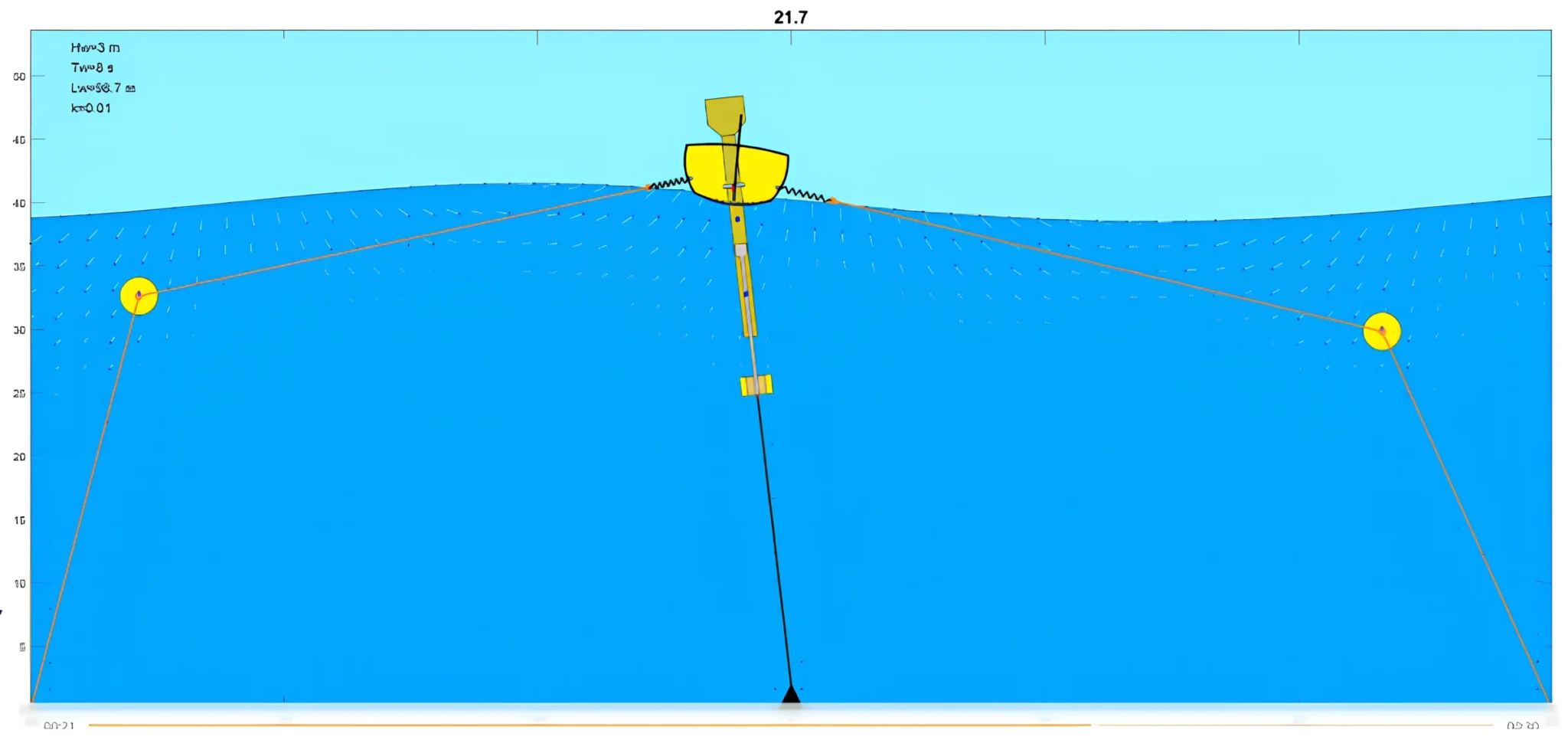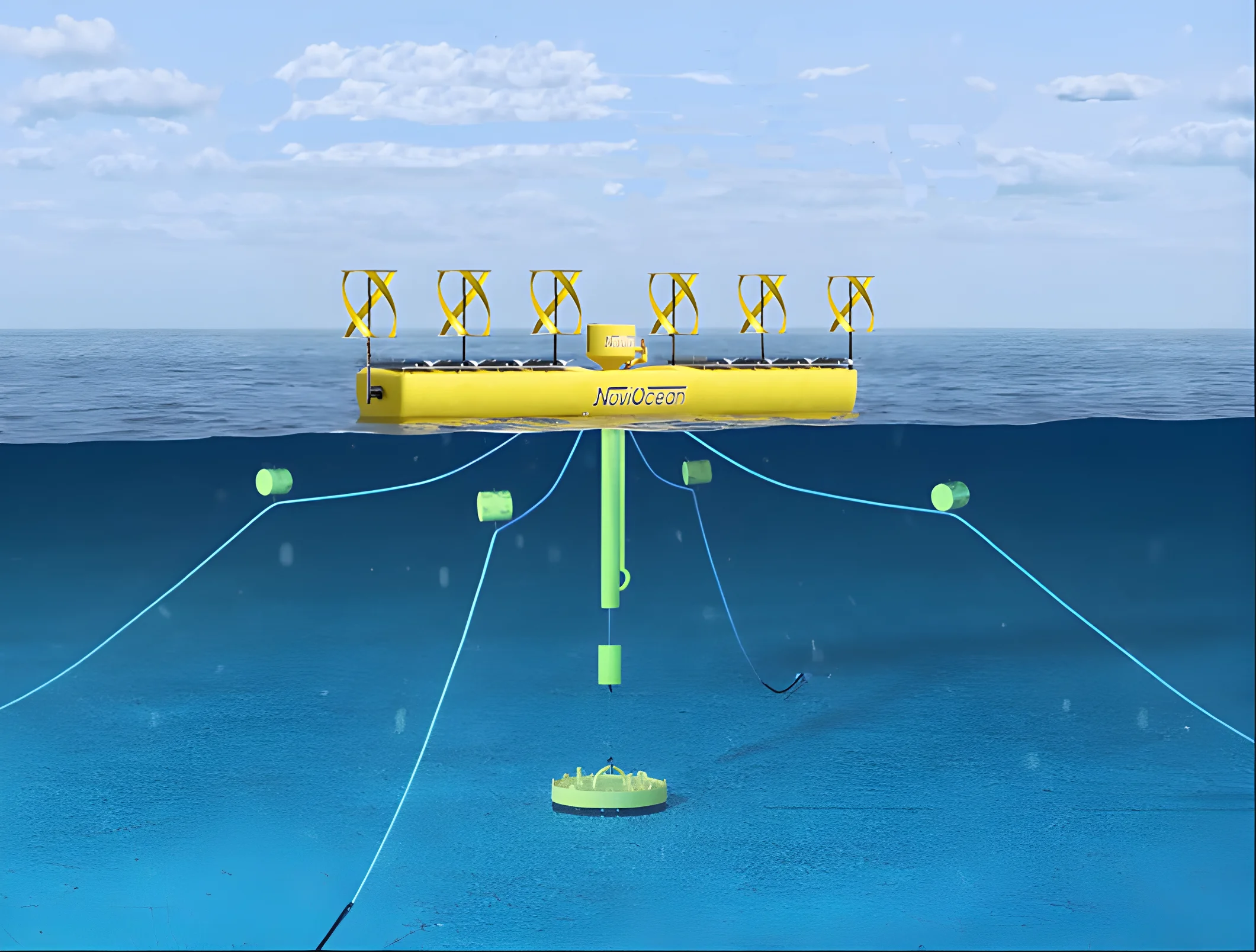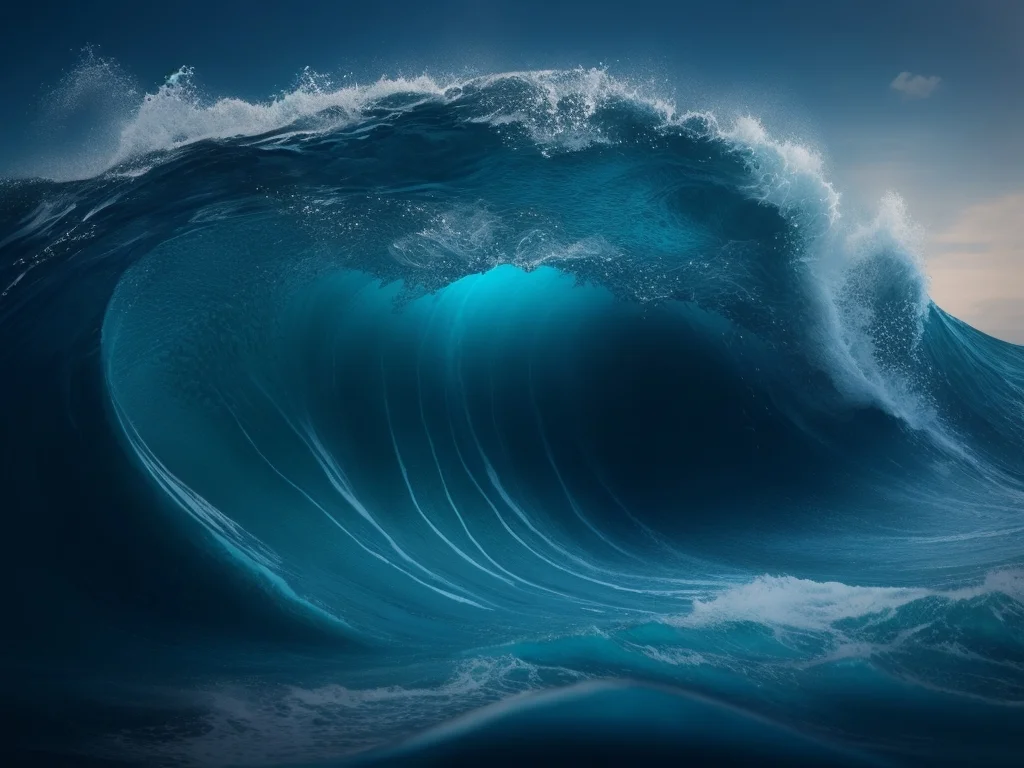1 MW Hybrid Solution
650 kW Wave, 300 kW Wind, 50 kW Solar.
(40% Capacity Factor | 3.5 GWh /unit/year)
Multi-award winning solution:
• ”The hybrid 1 MW wave, wind & solar power plant at sea”
• Three patents, 20 countries
All in one unit
• 650 kW wave, 300 kW wind,50 kW sun
• 40% Capacity Factor
Validated, all results matching:
• Third party simulations
• 24 months test rig runs
• Six weeks of tank testing
• 14 months 1/6 scale offshore testing
• All showing superior performance
Multi-award winning solution:
• ”The hybrid 1 MW wave, wind & solar power plant at sea”
• Three patents, 20 countries
All in one unit
• 650 kW wave, 300 kW wind,50 kW sun
• 40% Capacity Factor
Validated, all results matching:
• Third party simulations
• 24 months test rig runs
• Six weeks of tank testing
• 14 months 1/6 scale offshore testing
• All showing superior performance
NoviOcean Wave Energy Converter
The Science Behind Our Success
The NoviOcean Wave Energy Converter operates by ingeniously using buoyancy to capture the energy of ocean waves. Here's how it works:
How it Works
1. The rectangular shape resembles the wave’s shape.
2. When in the lowest point, valve closes, holding the float in a fixed position relative the sea floor.
3. The wave rises around the float, and up to three meters of the float is locked below water.
4. 600 cubic meters of air is trapped below surface.
5. Valve opens at correct pressure. 600 tons of lifting force pushes high pressure water onto the Pelton turbine, turning the generator.


How it Works
1. The rectangular shape resembles the wave’s shape.
2. When in the lowest point, valve closes, holding the float in a fixed position relative the sea floor.
3. The wave rises around the float, and up to three meters of the float is locked below water.
4. 600 cubic meters of air is trapped below surface.
5. Valve opens at correct pressure. 600 tons of lifting force pushes high pressure water onto the Pelton turbine, turning the generator.


Based on 3 well proven and simple parts:
Principles
1. large float
2. hydraulic cylinder
3. Pelton turbine
Simply the well-proven hydro power plant, taken to sea and inverted
Converting the slow wave motion to high-speed generator RPM, in the most simple and well proven way.
Lifting force vs surge force: 20 to 1!

Principles
1. large float
2. hydraulic cylinder
3. Pelton turbine
Simply the well-proven hydro power plant, taken to sea and inverted
Converting the slow wave motion to high-speed generator RPM, in the most simple and well proven way.
Lifting force vs surge force: 20 to 1!

1. Large Float
2. Turbine housing and Hydraulic Cylinder
3. Pelton Turbine
Storm Survivability
Uniquely Low Drag Forces Lifting Force vs Surge Force: 20 to 1!
Pic simulation 1: Maximum draft and drag forces in lifting mode.
Pic simulation 2: Minimum draft when free floating in the descending phase, or initiated “survival mode”
In 25-meter rogue waves, the surge forces are at maximum 33 tons per side. This is unique in relation to the massive 600 tons of lifting force
Uniquely Low Drag Forces due to:
1. Low Draft (depth in water)
2. Free Floating Design


Uniquely Low Drag Forces Lifting Force vs Surge Force: 20 to 1!
Pic simulation 1: Maximum draft and drag forces in lifting mode.
Pic simulation 2: Minimum draft when free floating in the descending phase, or initiated “survival mode”
In 25-meter rogue waves, the surge forces are at maximum 33 tons per side. This is unique in relation to the massive 600 tons of lifting force
Uniquely Low Drag Forces due to:
1. Low Draft (depth in water)
2. Free Floating Design


Storm Survivability
Blue curve shows results for constant spear valve setting k=0.0035 (no latching)
Red curve shows results for 60% latching (closed spear valve) followed by constant spear valve setting k=0.015
Mean Hydraulic Power vs Wave Height
Full scale Pilot NoviOcean NO 1000H

Storm Survivability
Blue curve shows results for constant spear valve setting k=0.0035 (no latching)
Red curve shows results for 60% latching (closed spear valve) followed by constant spear valve setting k=0.015
Mean Hydraulic Power vs Wave Height
Full scale Pilot NoviOcean NO 1000H

The proof is in the pudding!
The real performance matches the simulations to the point!
Simulations and tests show 3-30 times more output vs competition for the wave energy converter part
Extrapolated graphs based on offshore 1-6 scale prototype testing. The exact same model proves with no doubt the wave power unit will deliver 650 kW (after losses) in 4-meter waves. /Remember also to adjust to 650 kW.



The proof is in the pudding!
The real performance matches the simulations to the point!
Simulations and tests show 3-30 times more output vs competition for the wave energy converter part
Extrapolated graphs based on offshore 1-6 scale prototype testing. The exact same model proves with no doubt the wave power unit will deliver 650 kW (after losses) in 4-meter waves. /Remember also to adjust to 650 kW.



1 MW Hybrid Solution
650 kW wave, 300 kW wind, 50 kW solar
(40% capacity factor | 3.5 GWh/unit/year)
NoviOcean’s lifting force by buoyancy
is 600 tons in four-meter waves for a float net area of 260 sq. meters (38 x 8 m)
the solutions not using buoyancy
need about 30x larger area to create a similar force. This equals about 8 000 sq. m or 800 x 10 meters, which will be far too heavy and costly
To extract the needed
high amounts of energy per ton of material in the ocean, buoyant concepts are in our opinion the only realistic solution. The others are simply way too costly vs output
NoviOcean Wave Energy Convrter 650 kW
Vertical Wind Turbines 300 kW
Solar Panels 50 kW
* 45% higher output than with only wave power
* 1.5 x the output vs offshore wind, for the same sea area, 2.5 x if combined, stable output
* Other floating wind and solar solutions have 75% the costs for only the structure, cable and moorings
* Our floating wind and solar cost: 25-40% of other solutions, plus survives the highest waves
* 45% higher output than with only wave power
* 1.5 x the output vs offshore wind, for the same sea area, 2.5 x if combined, stable output
* Other floating wind and solar solutions have 75% the costs for only the structure, cable and moorings
* Our floating wind and solar cost: 25-40% of other solutions, plus survives the highest waves
1MW NoviOcean Hybrid Solution
Customer future add-on options:
Li-ion storage, H2 production, desalination
Triply Patented
with few, light, simple and well-proven components
HPAS concept
“Hydropower Plant at Sea” 38-meters long 150 tons
Stable, 24/7
delivery, less need for fossils and storage
NoviOcean
Advantages
Wave Energy
Our Journey
Future Goals
Investor Portal
1 MW Hybrid Solution
650 kW Wave, 300 kW Wind, 50 kW Solar.
(40% capacity Factor | 3.5 GWh /unit/year)
Lighter, low LCOE, more powerful – the future of clean, efficient energy
Wave energy: 5x denser than wind, 10x solar, available 24/7, highly predictable.
Since 2016, pioneering simplicity, efficiency, and sustainability in cleantech
By 2030, 0.5 GW contracted, and by 2050, 10 GW, reflecting our ambition to campture 25% of the EU’s 2050 target, worth E 30 billion in Europe alone. The global market is six times larger
Structured path: Full-scale prototype 2022, commercial phase by 2029. Cost-efficient tech, global partners, and a sustainable future. Let’s connect!






